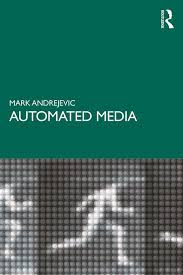Note: Upon first receiving a link to Jill Walker Rettberg's review of Automated Media in the journal Convergence from its author, I asked her if she would support my request to the journal to publish a response. Professor Walker Rettberg graciously agreed to this, so I approached the editors with this request. They replied that current editorial policy does not provide them with the latitude to publish my response, but agreed to promote it via social media.
Mark Andrejevic
Monash University
For the record, I don’t believe journals or reviewers have any obligation to promote new books in the field or to be positive about them in the interest of collegiality, solidarity, or politics. I do think, however, that reviewers have the fundamental obligation to be roughly accurate in their description of the book under review. It is this belief that prompted me to ask the editors of Convergence -- and the author of its recently released review of Automated Media (2019) -- to support the publication of a response to the review.
This decision was bolstered by the fact that I first learned of Jill Walker Rettberg’s (2020) review from several tweets she directed toward me on the occasion of the review’s online publication. This social media flurry felt like a direct invitation to respond in some way. I replied that I thought her review misconstrued the book’s main arguments, but that I didn't feel Twitter was suited to productive academic discussion, especially when there are substantive misunderstandings to be sorted out. My goal in this response is not to take issue with Professor Walker Rettberg’s core arguments, but to suggest that they miss their target. The strange thing to me about reading the review is how much I agree with the arguments she arrays against what she takes to be my own -- precisely because she gets the book's central claims exactly the wrong way around. There may be the makings of a debate here, but it cannot get off the ground until the mischaracterizations in the review are addressed.
The main ones center upon what the book describes as “the bias of automation” and also upon the notion that automated data collection might live up to the promise of “total coverage” or what the book describes as “framelessness” (that is, the fantasy of digitizing information about the world “in its entirety”).
The book starts off by differentiating between two meanings of the term “bias”: the first is a familiar one that refers to the fact that automated processes can systematically privilege or disadvantage particular groups. The examples here are myriad, ongoing, and alarming, warranting the robust critical attention they receive. The second meaning of bias invoked in the book is less common and draws on the work of Harold Innis -- discussed in some detail -- to suggest that the very choice to use a specific media technology (in a particular social context) can privilege particular logics and tendencies. The book notes that critical work on the first version of bias is well developed and crucially important, and argues for the importance of considering the consequences of the choice to use automated systems in the first place (within a particular context). The book's goal is to examine the logical tendencies that flow from this choice, describing them as “biases” in the way that we might describe, for example, market transactions as “biased” toward the assessment of value in ways that can be quantified. Such transactions may also be biased in the first sense as when, for example, they result in discriminatory outcomes for particular groups. I take these two levels of bias to be distinct, but they can certainly overlap -- as in practice they so often do.
The review overlooks this distinction, proceeding as if all mentions of bias refer to the first version, and faults the book for not engaging in more depth with the relevant literature on this. I strongly agree with Professor Walker Rettberg regarding the importance of this work, and I do think there is room for further development of the connection between these two forms of bias. There is also an interesting discussion to be had about what happens to the first sense of “bias” when we concede its irreducibility. However, neither of these discussions would justify the review’s wholesale assimilation of one meaning of bias to the other. Perhaps she thinks the distinction is untenable -- an interesting claim -- but this is not the argument advanced in the review.
The most confounding misreading, however, is the attempt to attribute to the book the very perspective it critiques: that automation can somehow escape the constraints of finitude and representation. Professor Rettberg accuses the book of not recognizing that, “the fantasy of total knowledge, of there being no gap between data and reality, is just that, a fantasy” (2). However this is, almost verbatim, the core repeated argument of the book.
The chapter on “framelessness” for example, refers to the ambition of digitally capturing and reproducing the world in its entirety as an impossible fantasy (see, for example, p. 114: "The fantasy of automation is that in the breadth of its reach, in the ambition of its scope, it can approach the post-subjective perspective of the view from everywhere -- or nowhere: the purely objective representation that leaves nothing out"; p. 115: p. 122: "Conspiracy theory defaults to a choice between an impossible standard of completeness (framelessness) and...gut instinct..."; p. 126: "There is a seemingly 'democratic' cast to the fantasy of framelessness").
To drive the point home, the book summarizes the examples it critiques as representing, “tendencies and trajectories – many of which, I want to emphasize, head in logically impossible directions such as, for example, the attempt to dispense with a frame entirely, to envision the possibility of a purely objective decision-making system, and to capture all information about everything, all the time” (160). It is no accident that the book uses the language of fantasy to describe the logics of pre-emption and framelessness: these are only conceivable from an impossible, infinite perspective -- as the book repeatedly argues.
Something similar takes place in the review with respect to Professor Walker Rettberg’s attribution to me of, “the idea that there is no gap between data and reality.” The book takes this very gap as one of its defining themes, as illustrated from the opening pages and in a number of passages, including the following: “Critiquing the post-political bias of automation means engaging with the possibility that the world does not work this way: that it cannot be captured and measured ‘all the way down,’ because there are irreducible uncertainties and gaps in reality” (101).
The book argues repeatedly that the fantasy of total information collection -- of overcoming the gap between representation and reality -- is both a structural tendency of automated technologies (“if this system is inaccurate, all it needs is more data, so that it can be better trained”) and an impossibility. To treat fantasies as if they have real consequences is not the same thing as saying they are real, true, or accurate. The book’s concern is directed toward these consequences.
Consider, for example, Professor Walker Rettberg’s accurate claim that emotion detection algorithms do not measure actual emotion -- that the data do not capture the supposed referent. The book points out that from an instrumental and operational perspective, the referent drops out. Imagine (as many tech companies have), a system that links “emotion detection” to a marketing campaign: a designated “emotional state” of some kind is associated with the increased likelihood of someone clicking on an ad and purchasing a product. Whether the machine has correctly identified the user’s state (the “referent” of the identified emotion) is immaterial to this correlational system: the “emotional state” becomes a vanishing mediator. What matters is the robustness of the correlation between one set of variables (facial expression, for example) and another (purchasing behavior).
Prof. Walker Rettberg attributes the supposed inability of the book to recognize the fantasy as such (despite repeated explanations for precisely why each of the fantasies it describes is incoherent and self-contradictory), as a function of its failure to engage with feminist and intersectional theory. This criticism overlooks the fact that much of the book's argument, including the entire final chapter, is influenced by the work of Alenka Zupancic (2017), a theorist who does groundbreaking work at the intersection of feminism, critical theory, and psychoanalytic theory. The chapter’s argument draws heavily on Zupancic's 2017 book, What is Sex?, which develops an original, psychoanalytically inflected argument to ground the very claim that Rettberg accuses it of ignoring: the non-identity of data and the world, sign and referent. As Zupancic puts it, "feminism (as a political movement) puts in question, and breaks precisely this unity of the world, based on massive suppression, subordination, and exclusion" (36).
The conclusion develops an extended interpretation of Zupancic's discussion of the impossibility of the perfected "relation" as a way of highlighting the fantastical biases of automation. That the review misconstrues this argument to the point of getting it backward is perhaps testimony to the fact that Zupancic has not received the attention in the field she deserves.
Professor Walker Rettberg’s review brings together interesting and important literature to make arguments that, in many cases, align with the book's key concerns. I find myself agreeing with most of the points she makes -- with the caveat that they do not apply to the book in the way she imagines. The review does an excellent job of demonstrating her familiarity with an important set of theories, arguments, and academics, but it does so at the expense of misreading and mischaracterizing the book's defining themes.
References:
Andrejevic, M (2019) Automated Media. New York, London: Routledge.
Innis, HA (2008). The Bias of Communication. Toronto: University of Toronto Press.
Rettberg, JW (2020) Book review. Convergence, first published online at: https://journals.sagepub.com/doi/abs/10.1177/1354856520906610.
Zupancic, A (2017). What is Sex? Cambridge: The MIT Press.


No comments:
Post a Comment